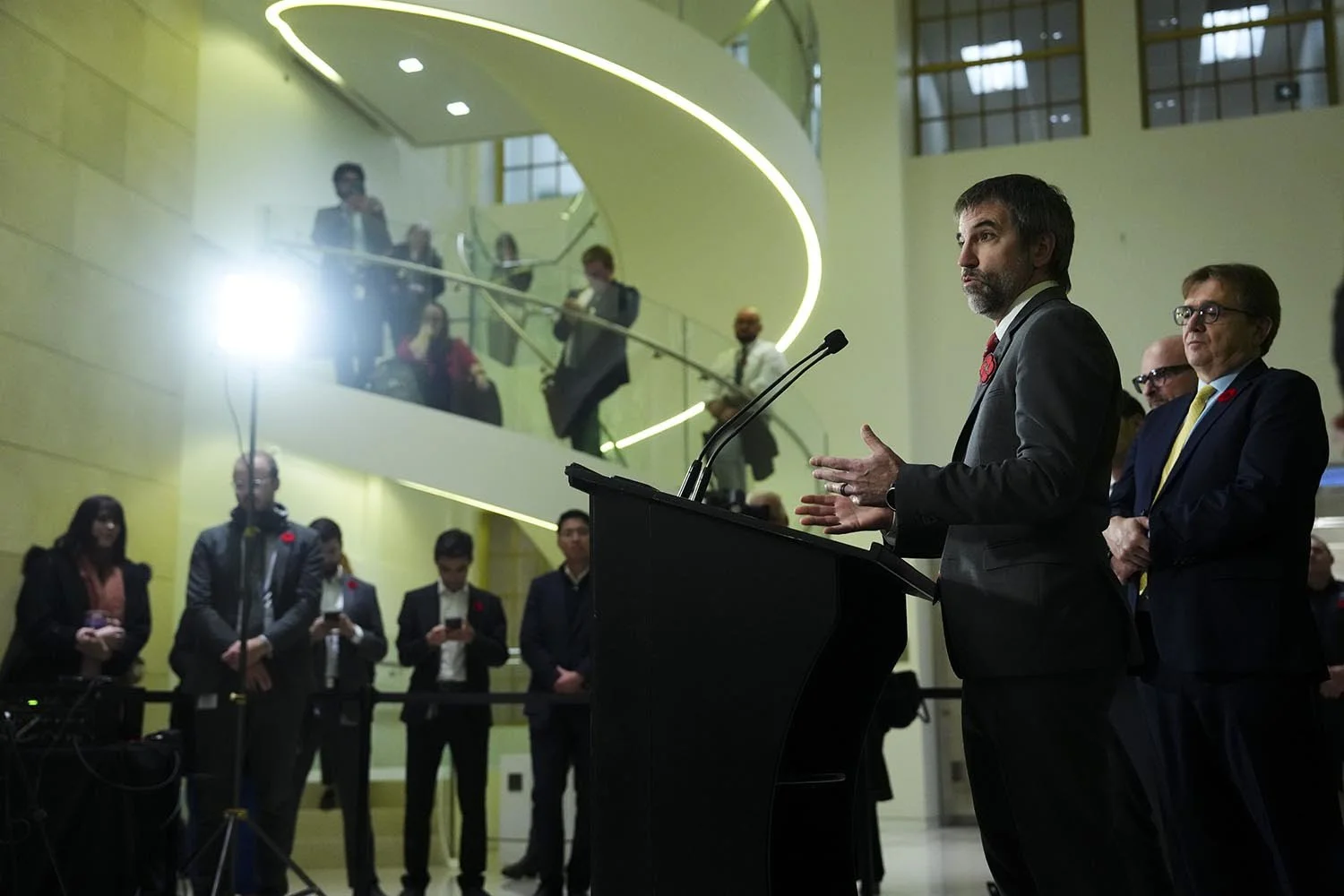Oil and gas emissions cap: a dead policy walking, unless…
THE CANADIAN PRESS/Sean Kilpatrick
Minister of Environment and Climate Change Steven Guilbeault joins Minister of Energy and Natural Resources Jonathan Wilkinson and fellow colleagues as they hold a press conference in Ottawa on Monday, Nov. 4, 2024. Oil and gas producers in Canada will be required to cut greenhouse gas emissions by about one-third over the next eight years under new regulations.
This week, Prime Minister Justin Trudeau’s government finally released draft regulations aimed at capping greenhouse gas emissions in our oil and gas sector, Canada’s largest source of export revenue.
The basic parameters of the proposed cap-and-trade system largely align with the government’s earlier plans, which aim to reduce the sector’s emissions by about a third from 2019 levels by 2030.
Critics of the cap—including the industry, most national business groups and the Alberta government—argue the plan is economically unfeasible and will effectively limit oil and gas production. In other words, the available incentives aren’t enough to justify maintaining current production levels under this framework.
The feds counter that the oil and gas industry, as Canada’s largest emitter of greenhouse gases, must contribute more if the country is to meet near-term emissions targets (which critics also say are too aggressive).
The bigger question, however, is whether any of this will actually matter. With the opposition Conservatives likely to take power at some point over the next 12 months, the policy will probably never be implemented.
It’s difficult to imagine Conservative Leader Pierre Poilievre sticking with an oil and gas cap—or even with the Liberals’ economy-wide target to cut national emissions by 40 per cent this decade. Poilievre would likely also reverse Trudeau’s regulations on methane and clean electricity.
This looming shift in the policy landscape suggests oil and gas executives will be tempted to wait for the next election, which could bring a fresh mandate from whoever wins power. Why invest if the rules are uncertain?
What we have here is a dead policy walking.
Making it real
Is there anyway to salvage it?
It’s unlikely the Liberals will water down their emissions targets. It’s also unlikely the oil sector will feel compelled to comply. The first “registration” requirement isn’t until early 2026, so the industry can essentially ignore it before the next election.
One way to bridge the divide—to make the policy real, in other words—would be to significantly increase subsidies to fully de-risk investment, making it a lot more carrot than stick. But this too is probably a long shot.
Currently, oil companies can access investment tax credits from both the federal and Alberta governments to cover about 60 per cent of capital costs for major projects, such as the proposed Pathways Alliance carbon capture network in Alberta.
However, there’s no provision yet to subsidize operating expenses, which could double the total costs over the lifespan of these facilities—a major sticking point.
What would a more attractive funding profile look like for the industry? A recent announcement from the U.K. provides one example.
Last month, Prime Minister Keir Starmer’s government pledged approximately $40 billion over 25 years for carbon capture and storage projects, with the private sector expected to contribute an additional $14 billion—a roughly three-to-one public-to-private ratio. In Canada, this would translate into many billions more in backstop funding than currently available for the sector’s low-carbon transition, whether from the federal government or Alberta.
Without increased funding to expedite carbon capture investments before the next election, this week’s announcement is more of a campaign plank than a realistic policy.
Epilogue
A few additional thoughts on this. The idea that the oil and gas cap will probably never get implemented won’t be a surprise to Trudeau’s administration. Maybe a disappointment, but not a surprise.
The timing of the announcement seems aimed at getting ahead of what’s expected to be a tough political environment in the coming months. An election is likely before next summer. We may actually never see final regs, which will only be published after more consultations. The Liberals want to show some progress going into an election campaign - which may be as good as it gets for them on the file.
The government would have had much more leverage had they moved sooner. So why the delay? I’m speculating, but here are a few possible explanations:
First, creating a new cap-and-trade system is complex and technically challenging, requiring extensive analysis, modeling and bureaucratic coordination. That takes time.
Second, the economic costs of getting it wrong are massive. This reality is often overlooked by those outside oil-producing regions who don’t see the direct benefits, but every Canadian would be poorer should the industry stagnate, and the effects could be immediate through a weaker currency. The government is factoring in significant flexibility for this reason: while the “headline” goal is to notionally reduce emissions by 35 percent from 2019 levels, the actual cap is 27 per cent below 2026 levels—an adjustment that accounts for possible production surges in the next few years.
Finally, the cap is just another layer on top of an already long list of policies - from carbon pricing to regulations for methane, fuel and electricity - that make up the federal government’s climate plan. The scaffolding of regulations and frameworks that Trudeau’s administration touts as a strength could be seen through an alternative lens - one that depicts a government that is unsure about what exactly it wants to do.






